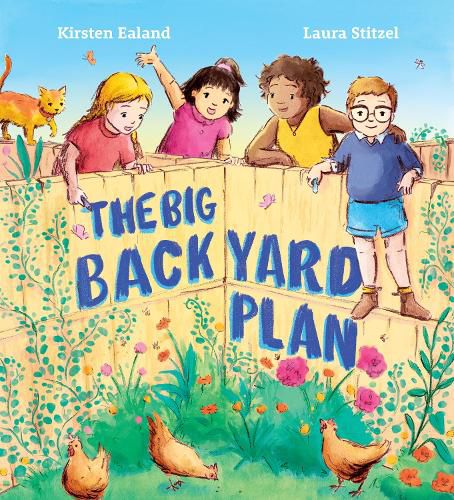The big backyard plan by Kirsten Ealand. Illus. by Laura Stitzel

Four friends, Jack, Bree, Theo and Azumi live side by side, their fences meeting a point where they can all talk together. They swim in one yard, skate in the next one, while they can help with the vegetable patch in one and feed the chickens in another. They loved their neighbourhood, but to reach their houses they had to walk around the block to the next street. So, someone had the idea of building gates. On the way home from school they began to plan and soon came the idea of one big backyard. They made plans to present to their parents, showing that there could be a bigger hen house and more space for vegetable gardens. They thought up reasons to give their families to bring them to their points of view. They watched as their parents discussed the idea over the fence, bringing up even more reasons to take down the old fences and share their yards. One day they all worked together and pulled down the old fences. The parents were still a little perplexed, and suggested they wait a month before making a decision. But the end of the month came and went, a new bigger hen house was built, wattle trees planted to help the native bees, and a handball court made.
This delightful story about the power of children to suggest and implement change, underpins the theme of climate change and the things that can be done in your own backyard. The children are eager to be able to see each other without the big walk around the block and look closely at what they could achieve if the fences were not there. This prompted the adults to see what could be done, and the more they thought about it, the more positive outcomes could be seen.
Charming illustrations cover each page, full of movement and interest as the children remain front and centre as the power behind the changes. Readers will love seeing what each backyard offers the children, and the differences the one big backyard makes for them. I loved seeing adults being part of the solution and their efforts to support the children, as they find themselves able to communicate more easily and establish relationships which will serve home well. This is a soft plea for a future in which people work together to make their families more able to cope with climate change. And readers will be able to offer their own ideas about what they would include if their backyard was fences.
Themes: Fences, Communication, Friendship, Neighbourhood.
Fran Knight